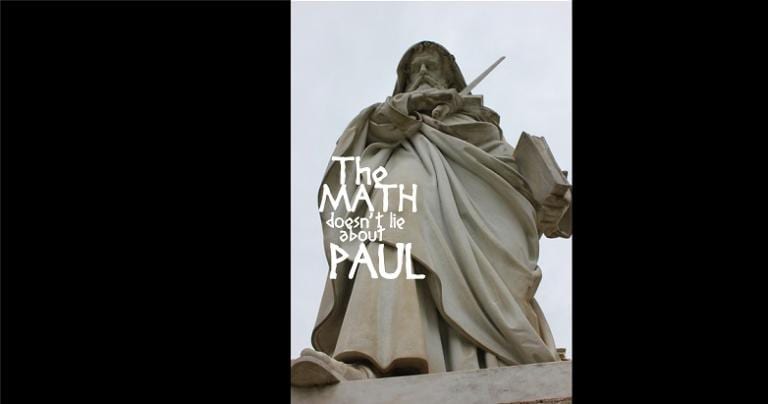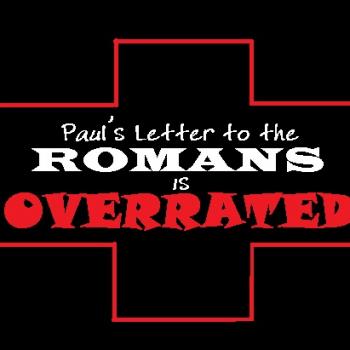
Math doesn’t lie about Paul’s evangelization.
In yesterday’s post, we discussed the reliability of our assumptions about the historical Paul being “the Apostle to the Gentiles.” We considered whether Paul’s Gospel was really heterophilous, meaning that Paul evangelized peoples belonging to different education, beliefs, social status, and cultural makeup.
But what if it wasn’t so? Contrary to spurious assumptions, what if Paul communicated in homophilous ways? In other words, what if Paul spread his Gospel to fellow Israelites, sharing his beliefs, education, social status, and cultural background?
There are weighty reasons to accept that the historical Paul wasn’t interested in non-Israelites. Among them is simple math. To understand what I mean about math, observe the video here—
What the Math Doesn’t Mean
Let’s breakdown what Dr. John Pilch presented.
First, don’t assume that by saying because Paul evangelized homophilously, Israelite emigres residing throughout the Mediterranean had no contact with non-Israelites. That’s nonsense. Of course, they did. But don’t imagine some kind of American melting pot situation. We need to realize that, no matter how mixed the urban center was, all Mediterranean peoples had fierce insider-outsider barriers. This would likewise apply to assimilated Israelite emigres living among non-Israelite majorities.
Also, no one is saying that in Paul’s day, there were no non-Israelite believers. Indeed, there were, even if very few. But there’s nothing in Paul’s seven authentic letters to indicate that he evangelized non-Israelites. Did Paul tolerate non-Israelite Messianists (“Christian” would be an anachronism)? Sure. Meanwhile, Paul roundly insults them in a letter given to Jesus groups he never founded (see Romans 11:13-24). More on that later.
Do the Math
Pilch and friends count the bishops attending the Council of Nicaea at 220. Some may balk, citing the traditional number of bishops being 318.
I love it when people talk about Nicaea (325 CE) as if television cameras were present. A young priest once arrogantly informed me that we know for sure that St. Nicholas decked Arius for insulting the Blessed Virgin at Nicaea. That’s sheer nonsense, but I’ll save that one for December.
There is so much we don’t know about Nicaea. The number of attending bishops is not known to metaphysical certainty. All “signature lists” are defective. Ancient sources known for inflation and exaggeration can’t even agree on the number of attending bishops. And these men count like they allegorize—wildly.
Running the Numbers
It’s highly likely that the traditional number of bishops present (318) is only symbolic (be suspicious!—the gematria for Eliezer = Lazarus, the servant/s of Abraham). Realistically it was between 220 and no more than 250. Modern scholars count 220. Eusebius (d. 339), patron saint of fundamentalists and Occupied Palestine “pilgrimages,” isn’t reliable. Sozomenus (d. 450), Rufinus (d. 411), and Theodoret (d. ca. 466) write long after him.
All the bishops who attended Nicaea—and Constantine summoned all of them—functioned in a face-to-face society. 21st century Western Christians, belonging to impersonal and unfeeling face-to-space relationships, have a hard time appreciating this.
As anthropologist Jeremy Boissevain maintains, in a face-to-face society, the maximum number of persons with whom one can interact is ≤ 4,000. Did every bishop’s flock count to 4,000? HARDLY—probably none did. Bruce Malina and John Pilch are being too generous! Realistically, the number was far lower! But let’s be generous like these scholars. Let’s imagine that every bishop cared for 4,000 believers each. This would more than handsomely make up for the few bishops who couldn’t attend.
Solid Math
Assuming this high count, the maximum number of believers by the time of the Nicaea was no more than 880,000. This is the result of a growth rate of ca. 2.5 percent per year. As some like Ramsay MacMullen do, to postulate, that by 325 Christians made up ten percent of the Roman Empire is a ridiculous exaggeration, but typical from the times that followed. See Bruce Malina’s book Review of Rodney Stark’s “The Rise of Christianity,” in “The Catholic Biblical Quarterly” 59 (1997): pp. 593-595.
The math holds. It points to snail’s paced homophilous evangelization.
Math & First Century Synagogues
The historical Paul evangelized Israelites, folks. When he reached a polis, he would head for the Israelite section in town. He would go to the synagogue. Jesus did this also in his day back in the Galilean villages. But what were synagogues in the first century? Don’t think Jewish synagogue.
It wasn’t until the late first century CE that synagogues began to evolve into what we have come to know them. Heather McKay argues that from Jesus’ day until about 200 CE, “synagogue” was a community center for Israelite males (see “Sabbath and Synagogue: The Question of Sabbath Worship in Ancient Judaism”). There, Israelite men gathered (like the Greek, synagogē, suggests) to hear the Torah read (political religion) and to dispute and argue (Luke 4:16-30 and parallels). They would cuss, spit, and get into heated exchanges.
But don’t think that these very different first-century male gatherings had any worship services. Back then, the Sabbath wasn’t a day of worship but of rest. It wasn’t until long after Paul that synagogues and Sabbaths changed to center on worship.
Math & Nomenclature
For these and so many other reasons, we have to stop thinking of anyone in the first century being Jewish, Christian, or pagan. Whenever we 21st century Westerners use these words, they indicate groups and values existing at the time of Constantine, or after him.
I can honestly say that there are Christians today because they trace back to the political religion of Roman Emperor Constantine and the Councils that followed (i.e., Christendom). Was Paul from those times? No way! So, therefore, he wasn’t Christian and didn’t convert to Christianity. And Paul couldn’t bring anyone, whether his fellow Israelites or the non-Israelites he didn’t care about, into the Christian fold. Why? Because it would be as impossible as time-travel for Paul.
And let’s get real about first-century pagans. There weren’t any. It wasn’t until after Constantine that Christian elites coined the term, labeling it on non-Christians (see James J. O’Donnell’s “The Demise of Paganism,” in Traditio 35, pp. 45-88). So you can forget about Paul converting any pagans.
And since the Jewish traditions trace back to the Talmud around 500 CE, we can forget about Paul or any other first-century person being Jewish. Therefore Paul didn’t convert from Judaism to Christianity.
What would be more appropriate designations then? Following Pilch, Malina, and John Elliott, when dealing with Paul, instead of Christian, use “Messianist.” Instead of pagan, use Gentile or non-Israelite. And instead of Jew, use Judaean or Israelite.
Where Does the Math Leave Us?
Does any of this make our faith invalid? No. Does it dismiss or debunk the Holy Spirit at work in the messiness of Nicaea, Constantinople (381), Ephesus (421), Chalcedon (451), or subsequent ecumenical councils? Nope. But it suggests we have some cleaning up to do in our prejudiced ideas and wishful thinking, Bible translations, homilies, and a lot more. This is especially true of much “information” gained by triumphalist, fundamentalist Catholic popular speakers, and so-called “apologists.”
Repeatedly we hear the self-appointed “defenders of the faith” proclaim spurious facts as “obvious!” and “clear!” Sorry fellow Catholics, but things aren’t evident and clear-cut as we would like. It’s time to grow up. More later…












